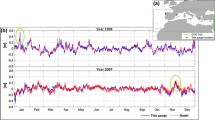Abstract
Statistical methods are still the basic tool for investigating random, extreme events occurring in hydrosphere. On 21-22 September 2017, in Warsaw (Poland) the international workshop of the Statistical Hydrology (StaHy) 2017 took place under the auspices of the International Association of Hydrological Sciences. The authors of the presentations proposed to publish their research results in the Special Issue of the Acta Geophysica–‘New Insight into Statistical Hydrology’. Five papers were selected for publication, touching on the most crucial issues of statistical methodology in hydrology.
Similar content being viewed by others
Avoid common mistakes on your manuscript.
Despite the rapid development of deterministic methods of modelling of hydrological phenomena, the statistical methods remain the basic tool for investigating the random and/or extreme events occurring in hydrosphere. Statistical approach developed by specialists in geophysics, hydrologists, environmentalists, and mathematicians finds a sound application in the study of various aspects of water modelling, management, and protection. Statistical procedures are often the only (or at least the easiest) way to calculate the risk and uncertainty associated with extreme hydrological phenomena, such as torrential rains, floods, or droughts. They also help in the analysis of the measurement data sets, detection and minimisation of measurement errors, reconstruction of paleohydrological information, and other problems encountered in the contemporary hydrology, which, to the large extent, still remain unsolved.
On 21 and 22 September 2017, in Warsaw (Poland), the International Workshop of the Statistical Hydrology (StaHy) 2017 took place under the auspices of the International Association of Hydrological Sciences (IAHS). It was the eighth meeting of a group of scientists, practitioners, and students from around the world under the patronage of STAHY. Eminent scientists from Poland and abroad were invited to participate in the workshop; 33 abstracts were submitted and the number of participants representing various countries in Europe, Asia, Africa, and both Americas and Australia exceeded 45. The subjects discussed at the conference concerned mainly the statistical methods of examining the random nature of hydrological and meteorological phenomena. The conference was also an opportunity to formulate and discuss contemporary problems faced by hydrologists and scientists. The questions formulated during the conference are currently the basis for the study of groups of hydrologists centred around IAHS.
The authors of the STAHY 2017 presentations were proposed to publish their research results in Special Issue of the Acta Geophysica—‘New Insight into Statistical Hydrology’. Five papers were selected for publishing. The articles in this special number touch on the most crucial issues of statistical methodology applied to solve hydrological problems and reflect the vast range of the activities of the modern statistical hydrology. One of the important hydrological topics analysed here concerns the investigations of the ability of rainfall–runoff model parameters to cope with three types of the existing errors, timing, shape, and volume as the common errors in hydrological modelling. Noticeably different origins of ‘summer’ and ‘winter’ hydrological phenomena resulted in the development of the seasonal approach in statistical hydrology, which was also deeply studied in one of the published papers. Furthermore, in consequence of the climatic variabilities, there is a need to quantify changes in future flood magnitude and seasonality at the catchment scale by means of statistical inference and methods. The bivariate character or multivariate character of many random hydrological processes caused that the copula functions have come within the scope of the statistical hydrology for the last few years and, naturally, a subject of a paper in the special issue. The fifth paper considers an original system for series forecasting based on advanced statistical and stochastic techniques.
I believe that the selection of the papers on a new insight into the statistical hydrology will satisfy the readers and point into new research directions in hydrological sciences.
Author information
Authors and Affiliations
Corresponding author
Rights and permissions
Open Access This article is distributed under the terms of the Creative Commons Attribution 4.0 International License (http://creativecommons.org/licenses/by/4.0/), which permits unrestricted use, distribution, and reproduction in any medium, provided you give appropriate credit to the original author(s) and the source, provide a link to the Creative Commons license, and indicate if changes were made.
About this article
Cite this article
Kochanek, K. ‘New insight into statistical hydrology’ preface to the special issue. Acta Geophys. 66, 739–740 (2018). https://doi.org/10.1007/s11600-018-0151-0
Received:
Accepted:
Published:
Issue Date:
DOI: https://doi.org/10.1007/s11600-018-0151-0




